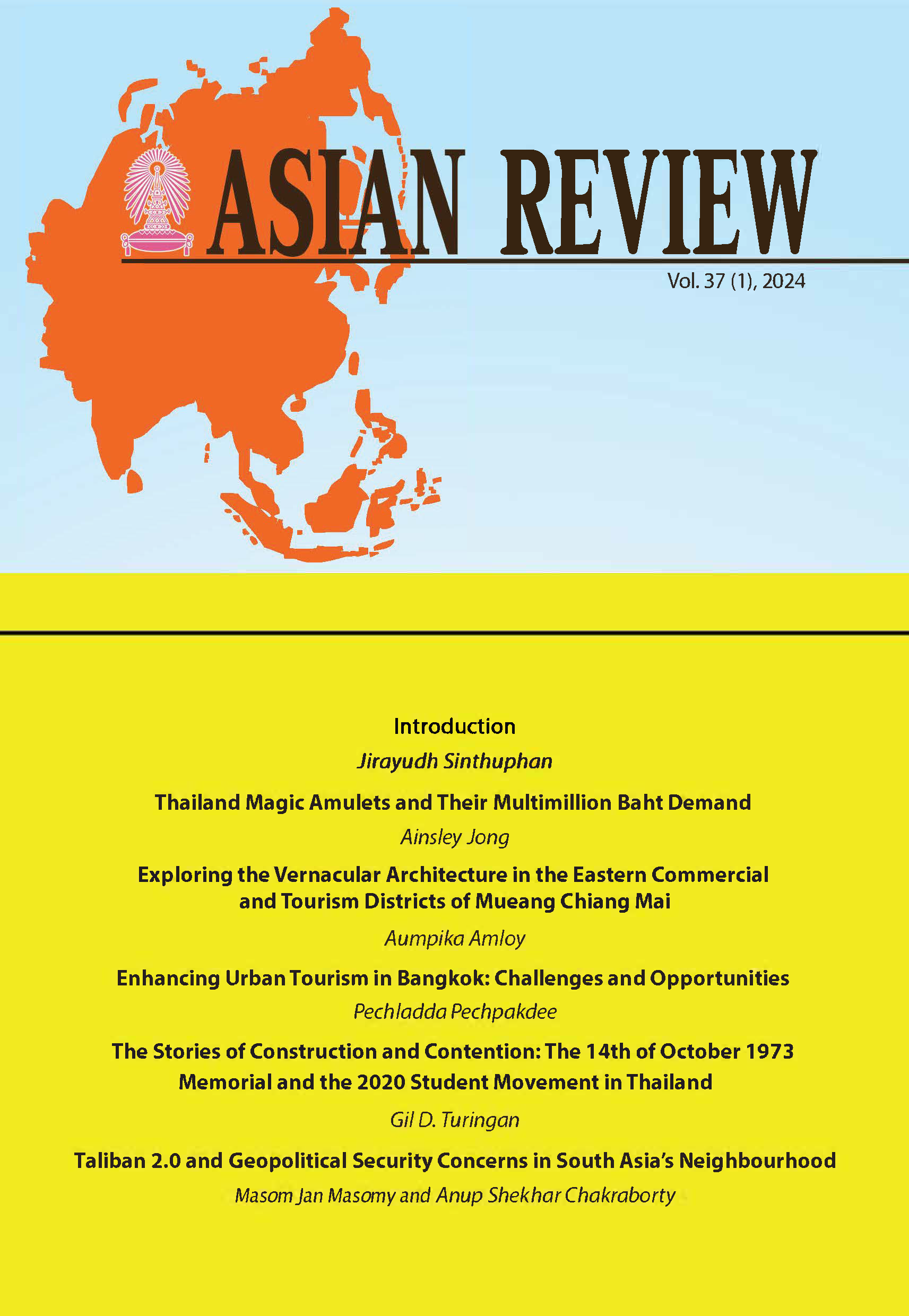Enhancing Urban Tourism in Bangkok: Challenges and Opportunities
DOI:
https://doi.org/10.14456/arv.2024.3Abstract
T
This research aims to investigate the interplay between urban development and urban tourism in Bangkok by identifying challenges, potentials, and opportunities for enhancing the city's appeal. Utilizing a mixed-methods approach, the study incorporates foreign tourist questionnaires, stakeholder interviews, and online open data analysis from prominent travel platforms. The findings reveal that, despite numerous clusters of tourist attractions and facilities, mobility infrastructure emerges as the most significant challenge for urban tourism and development in Bangkok. The study recommends concentrating on the development of primary attractions, secondary support facilities, and additional elements for convenient mobility to address these challenges. By acknowledging the strengths of Bangkok's diverse tourist attraction clusters and their proximity to primary and secondary elements, the research underscores the need for improved mobility facilities for tourists. This study contributes valuable insights into the challenges cities face in promoting urban tourism and emphasizes the critical role of mobility infrastructure for Bangkok Metropolitan Administration (BMA).
References
Ashworth, G., & Page, S. J. (2011). Urban tourism research: Recent progress and current paradoxes. Tourism Management, 32(1), 1-15.
Ashworth, G. J. (2003). Urban tourism: still an imbalance in attention? In C. Cooper (Ed.), Classic reviews in tourism (pp. 143-163). Clevedon: Channel View.
Aung, H., Nge, T., & Hichitake, Y. (2015). Destination image of Thailand and Singapore. APHEIT International Journal, 4(2), 1-10.
Bangkok Metropolitan Administration. (2013). Bangkok 20-year development plan (2013-2033). Bangkok: Bangkok Metropolitan Administration.
Cambridge Dictionary. (2020). Path. Retrieved from Cambridge Dictionary: https://dictionary.cambridge.org/dictionary/english/path
Cebeillac, A. A. (2021). What can we learn from Airbnb data on tourist flows? A case study on Iceland. Un Espace de Mobilités, 1-34.
Certo, S. (2000). Modern management. Upper Saddle River, NJ: Prentice Hall. Conyers, D., & Hills, P. J. (1984). An introduction to development planning in the Third World. Wiley. Euromonitor
Report. (2019). Top 100 City Destinations 2019 report. Retrieved from Euromonitor: https://go.euromonitor.com/white-paper-travel-2019-100-cities.html
Filomena, G. V. (2019). A computational approach to "The image of the city". Cities, 89, 14-25.
Global Destinations Cities Index (GCDI). (2019, November 16). Global destinations cities index 2019. Retrieved from Mastercard Newsroom: https://newsroom.mastercard.com/wp-content/uploads/2019/09/GDCI-Global-Report-FINAL1.pdf
Hillier, B. and Iida, S. (2005) Network and psychological effects in urban movement. In: Cohn, A.G. and Mark, D.M., (eds.) Proceedings of Spatial Information Theory: International Conference, COSIT 2005,Ellicottsville, N.Y., U.S.A.,September 14-18, 2005. Lecture Notes in Computer Science (Vol. 3693). Springer-Verlag, Berlin, Germany, pp. 475-490.. 475-490. 10.1007/11556114_30.
Ismail, H., & Baum, T. (2006). Urban tourism in developing countries: A case of Malaysia. An International Journal of Tourism and Hospitality Research, 211-233.
Jansen-Verbeke, M. (1986). Inner-city tourism. Annals of Tourism Research, 13(1), 79-100. Judd, D. R., & Fainstein, S. S. (1999). The tourist city. New Haven: Yale University Press.
Law, C. (2002). Urban tourism: The visitor economy and the growth of large cities. EMEA: Thomson Learning.
Lynch, K. (1960). The image of the city. Cambridge, MA: MIT Press.
Lynch, K. (1977). Growing up in cities. London: MIT Press.
Manakitsomboon, H. (2021). Tourism industry in Thailand - statistics & facts. Retrieved from Statista: https://www.statista.com/topics/6845/tourism-industry-in-thailand/#dossierKeyFig.s Massay, D. (1994). Space, place, and gender. UK: Polity Press. Ministry of Tourism and Sports. (2019). Tourism data of Thailand. Bangkok: Ministry of Tourism and Sports.
Morrison, A., & Maxim, C. (2021). World tourism cities: A systematic approach to urban tourism. London: Routledge. Mullins, P. (1999). International tourism and the cities of Southeast Asia. In D. Judd & S. S. Fainstein (Eds.), The tourist city (pp. 143-163). New Haven: Yale University Press.
Oppermann, M., & Chon, K.-S. (1997). Tourism in developing countries. London: International Thomson Business Press.
Pearce, D. G. (2001). An integrative framework for urban tourism research. Annals of Tourism Research, 28(4), 926-946.
Pérez, M., Laprise, M., & Rey, E. (2008). Sustainable urban renewal at the neighborhood scale with a spatial decision support. Sustainability, Cities and Society, 38, 440-451.
The Ministry of Tourism and Sports. (2017). The second national tourism development plan (2017-2021). Bangkok: Office of Permanent Secretary in The Ministry of Tourism and Sports.
Webster, D., & Muller, L. (2000). Urban competitiveness assessment in developing countries. Washington, DC: World Bank.
World Economic Forum (WEF). (2015). The travel & tourism competitiveness report 2015. Geneva: World Economic Forum.
World Tourism Organization. (2019). Urban Tourism: Market Intelligence and Competitiveness. Retrieved (accessed March 11, 2019) from https://www.unwto.org/urban-tourism#:~:text=According%20to%20UNWTO%2C%20Urban%20Tourism,being%20nodal%20points%20of%20transport.
Yuda, M. (2020). Smog-choked Bangkok struggles to improve air quality.
Retrieved (September 25, 2022)
from
https://asia.nikkei.com/Spotlight/Environment/Smog-choked-Bangkok-
struggles-to-improve-air-quality
Downloads
Published
How to Cite
Issue
Section
License
Copyright (c) 2024 Instiute of Asian Studies, Chulalongkorn University

This work is licensed under a Creative Commons Attribution-NonCommercial-NoDerivatives 4.0 International License.
Published articles are under the copyright of the Instiute of Asian Studies, Chulalongkorn University. Partially or totally publication of an article elsewhere is possible only after the consent from the editors.







